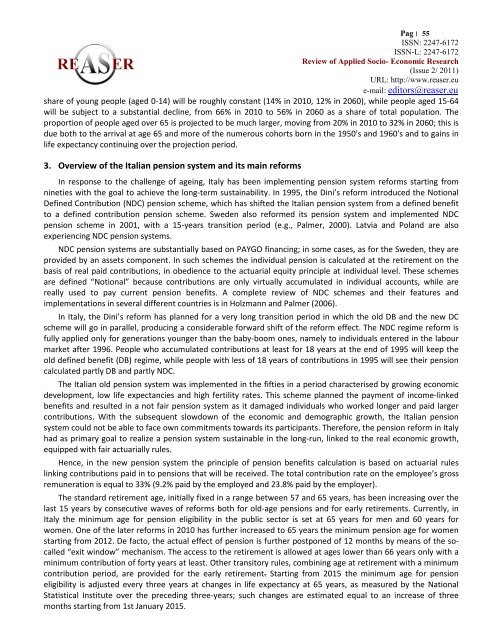Volume 2, ISSUE2/2011 - Review of Applied Socio-Economic ...
Volume 2, ISSUE2/2011 - Review of Applied Socio-Economic ...
Volume 2, ISSUE2/2011 - Review of Applied Socio-Economic ...
Create successful ePaper yourself
Turn your PDF publications into a flip-book with our unique Google optimized e-Paper software.
Pag׀ 55 ISSN: 2247-6172ISSN-L: 2247-6172<strong>Review</strong> <strong>of</strong> <strong>Applied</strong> <strong>Socio</strong>- <strong>Economic</strong> Research(Issue 2/ <strong>2011</strong>)URL: http://www.reaser.eue-mail: editors@reaser.eushare <strong>of</strong> young people (aged 0-14) will be roughly constant (14% in 2010, 12% in 2060), while people aged 15-64will be subject to a substantial decline, from 66% in 2010 to 56% in 2060 as a share <strong>of</strong> total population. Theproportion <strong>of</strong> people aged over 65 is projected to be much larger, moving from 20% in 2010 to 32% in 2060; this isdue both to the arrival at age 65 and more <strong>of</strong> the numerous cohorts born in the 1950's and 1960's and to gains inlife expectancy continuing over the projection period.3. Overview <strong>of</strong> the Italian pension system and its main reformsIn response to the challenge <strong>of</strong> ageing, Italy has been implementing pension system reforms starting fromnineties with the goal to achieve the long-term sustainability. In 1995, the Dini’s reform introduced the NotionalDefined Contribution (NDC) pension scheme, which has shifted the Italian pension system from a defined benefitto a defined contribution pension scheme. Sweden also reformed its pension system and implemented NDCpension scheme in 2001, with a 15-years transition period (e.g., Palmer, 2000). Latvia and Poland are alsoexperiencing NDC pension systems.NDC pension systems are substantially based on PAYGO financing; in some cases, as for the Sweden, they areprovided by an assets component. In such schemes the individual pension is calculated at the retirement on thebasis <strong>of</strong> real paid contributions, in obedience to the actuarial equity principle at individual level. These schemesare defined “Notional” because contributions are only virtually accumulated in individual accounts, while arereally used to pay current pension benefits. A complete review <strong>of</strong> NDC schemes and their features andimplementations in several different countries is in Holzmann and Palmer (2006).In Italy, the Dini’s reform has planned for a very long transition period in which the old DB and the new DCscheme will go in parallel, producing a considerable forward shift <strong>of</strong> the reform effect. The NDC regime reform isfully applied only for generations younger than the baby-boom ones, namely to individuals entered in the labourmarket after 1996. People who accumulated contributions at least for 18 years at the end <strong>of</strong> 1995 will keep theold defined benefit (DB) regime, while people with less <strong>of</strong> 18 years <strong>of</strong> contributions in 1995 will see their pensioncalculated partly DB and partly NDC.The Italian old pension system was implemented in the fifties in a period characterised by growing economicdevelopment, low life expectancies and high fertility rates. This scheme planned the payment <strong>of</strong> income-linkedbenefits and resulted in a not fair pension system as it damaged individuals who worked longer and paid largercontributions. With the subsequent slowdown <strong>of</strong> the economic and demographic growth, the Italian pensionsystem could not be able to face own commitments towards its participants. Therefore, the pension reform in Italyhad as primary goal to realize a pension system sustainable in the long-run, linked to the real economic growth,equipped with fair actuarially rules.Hence, in the new pension system the principle <strong>of</strong> pension benefits calculation is based on actuarial ruleslinking contributions paid in to pensions that will be received. The total contribution rate on the employee’s grossremuneration is equal to 33% (9.2% paid by the employed and 23.8% paid by the employer).The standard retirement age, initially fixed in a range between 57 and 65 years, has been increasing over thelast 15 years by consecutive waves <strong>of</strong> reforms both for old-age pensions and for early retirements. Currently, inItaly the minimum age for pension eligibility in the public sector is set at 65 years for men and 60 years forwomen. One <strong>of</strong> the later reforms in 2010 has further increased to 65 years the minimum pension age for womenstarting from 2012. De facto, the actual effect <strong>of</strong> pension is further postponed <strong>of</strong> 12 months by means <strong>of</strong> the socalled“exit window” mechanism. The access to the retirement is allowed at ages lower than 66 years only with aminimum contribution <strong>of</strong> forty years at least. Other transitory rules, combining age at retirement with a minimumcontribution period, are provided for the early retirement. Starting from 2015 the minimum age for pensioneligibility is adjusted every three years at changes in life expectancy at 65 years, as measured by the NationalStatistical Institute over the preceding three-years; such changes are estimated equal to an increase <strong>of</strong> threemonths starting from 1st January 2015.








